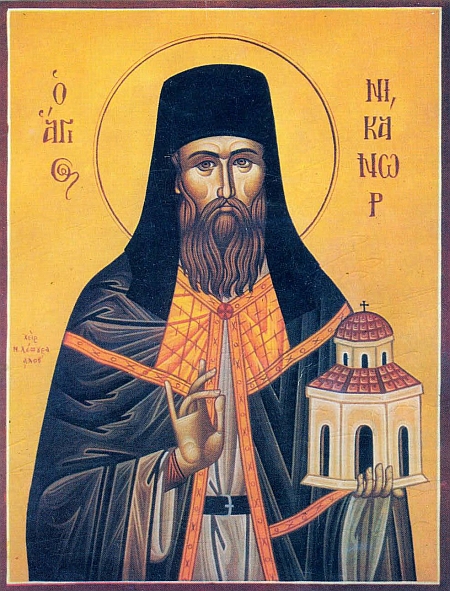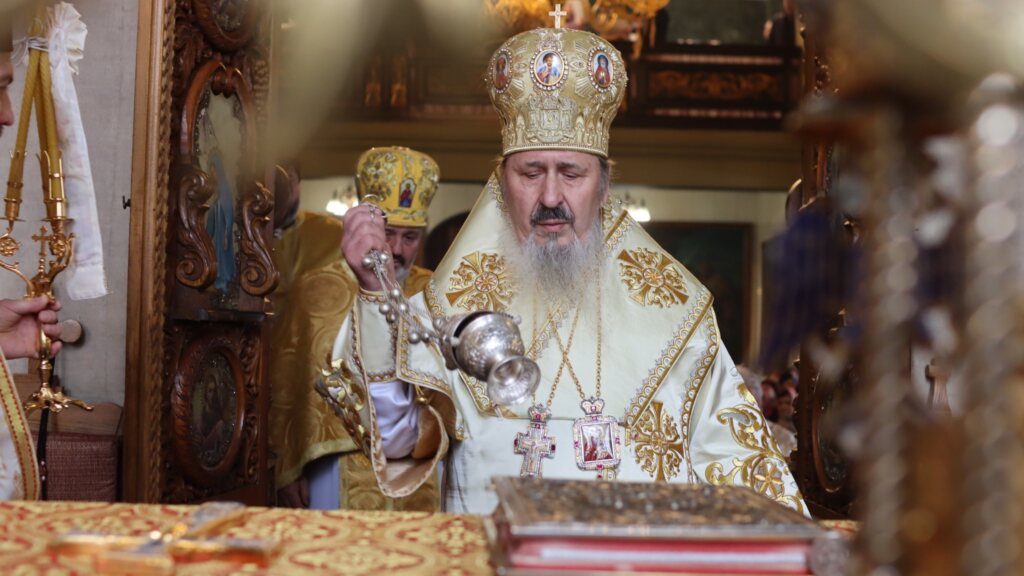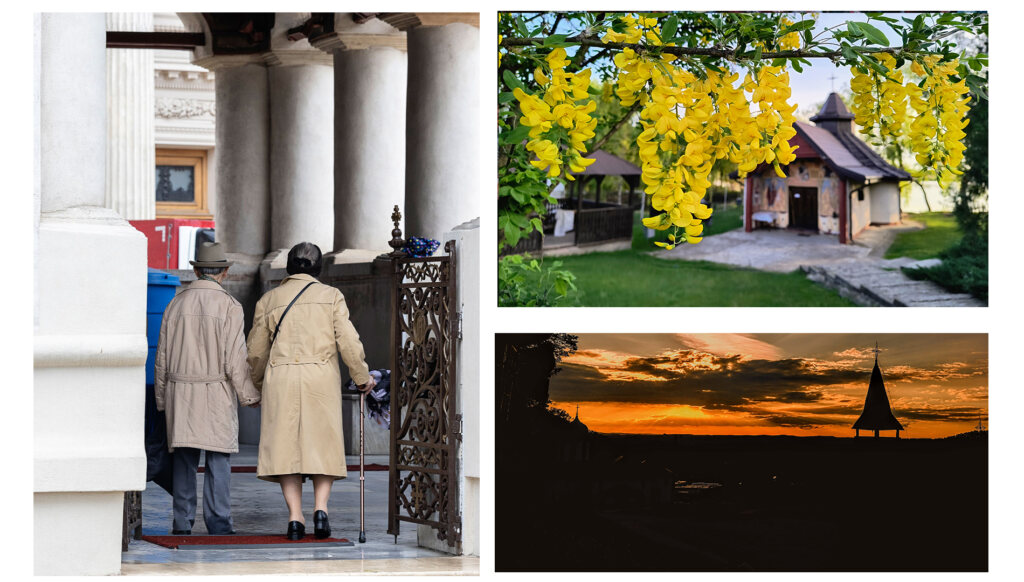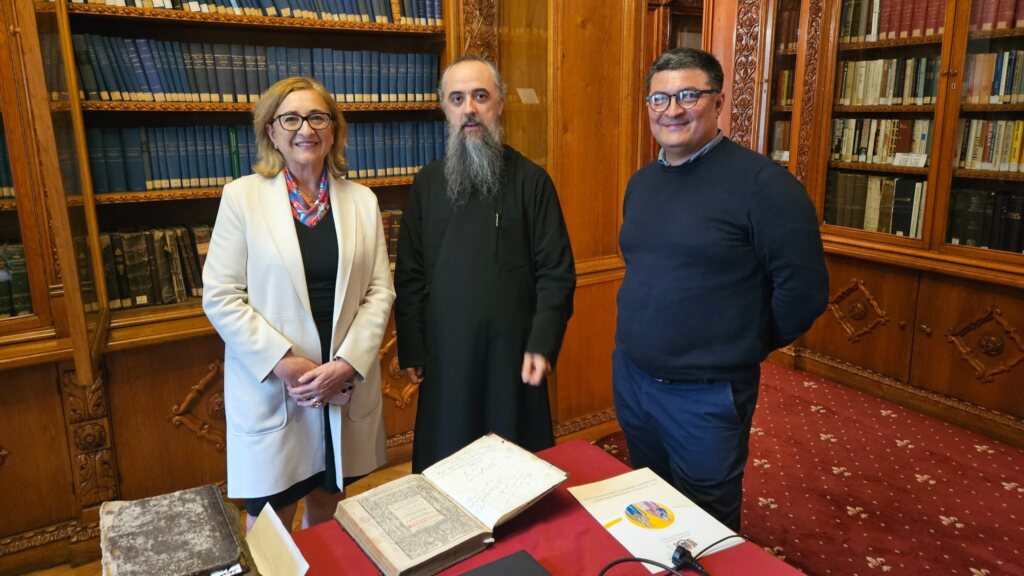This spiritual flower and bride of Christ that the blessed land of Moldavia gave birth to, was born about the middle of the 17th century, in Vânători-Neamţ village, to righteous parents obedient to God.
Her father, Ştefan Joldea the Armorer was a guardian at the Citadel of Neamţ and warden, as his name shows, namely he made weapons for those who were guarding the famous Moldavian Citadel. Her mother, whose name is not known, took care of her household and of the good education of her two daughters, Theodora and Maghiţa (Marghioliţa), in God’s faith.
Soon the younger daughter died and blessed Theodora grew in prayer and good deeds, loving Christ from the bottom of her heart and wishing to dedicate all her life to Him, advised by her father confessor, Saint John from Râşca, abbot of Neamţ Monastery at the time. But the will of her parents was different, so that Theodora was married against her own will to a religious young man from Ismail.
Because they had no children and Theodora’s soul was so much devoted to loving Christ wishing to live a pure life dedicated only to Him, they agreed to join the monastic life. The great hermits, her old spiritual advisers, who were living in the forests and mountains of Neamţ region, as well as her father confessor, who knew her religious nature and aspirations for mystical prayer urged her to embrace a life in asceticism.
Therefore, pious Theodora joined the monastic life at Vărzăreşti Skete, Vrancea and after two years her husband became a monk at Poiana Mărului Skete, with the name of Eleftherios. Thus, God guided them both to take the path of holiness and salvation.
At Vărzăreşti Skete, every nun strived to live for Christ, but pious Theodora exceeded all the other ones in prayer, humbleness and spiritual endeavour.
After a few years, the Turks invaded that part of the world and put fire to Vărzăreşti Skete. All the sisters of the community fled to the century old forests of the region waiting the danger and anger of God to pass. So did pious Theodora. She retired to Vrancea Mountains together with her abbess, schema-nun Paisia, whose disciple she was. They lived there alone, helped by God, in fasting and prayer, suffering much temptation from devils, hunger, cold and all kind of trials.
After her abbess died, pious Theodora left the Vrancea Mountains as a result of a divine revelation and withdrew in Neamţ region, to live in the untouched forests around Sihăstria and Sihla Sketes. First, she prayed to the miracle working icon of the Mother of God from Neamţ Monastery and then the igumen of the lavra sent her to Sihăstria Skete to take the advice of the local igumen.
After receiving the blessing of hieroschimonk Barsanuphius, the igumen of Sihăstria Monastery, pious Theodora was entrusted to father confessor Pavel, who took her to the forest, close to Sihla Skete, urging her to remain there until her death, if she would be able to endure the hard ascetic life, or settle at a nuns’ convent if she could not overcome the temptations and cold winter.
This is how pious Theodora arrived in the Sihla Mountains, where an old hermit offered her his cell under the huge rocks of Sihla and he found another shelter in a more secluded place. It was there that pious Theodora lived bravely for many years, alone, fasting and saying prayers all night long, in tears and bowing, far from the world.
Only her father confessor, pious Pavel from Sihăstria, came from time to time to her, when he listened to her confession, offered her the Body and Blood of Christ and brought her what she needed.
After a while, her father confessor died and pious Theodora remained quite alone, because nobody knew her place and hard life. Her clothes turned into rags in the course of time and she ate only sour weed, forest fruits and hazelnuts. Having attended this harsh school of peacefulness and quietness she received the gift of the prayer with fire felt in the heart, the gift of tears, of patience and of the untold great love for God.
Now she did no longer felt cold, hunger, and the devils could not defeat her, because she was a bright gem in the Sihla Mountains, forgotten by humans, but always protected by the grace of the Holy Spirit.
When the Turks invaded the monasteries and villages they came up to Sihla, but Saint Theodora was sheltered in her cave nearby. The pagans found her and she prayed God to save her. That moment, miraculously a rock at the bottom of the cave broke, as it can be still seen today, and the saint was saved.
It was in this cave that Saint Theodora lived during the last years of her life. She permanently said the heart’s prayer, her face brightened up and her body was raising from the ground, just like that of Saint Mary of Egypt. From time to time, by God’s will, the birds brought her crumbs of bread from the refectory of Sihăstria Skete in their beaks and she drank water from the hole in a rock nearby, called until today „Fountain of Saint Theodora”.
When she knew that the end of her life was near and that Christ was calling her to the heavenly places where there is the peace and delight of all saints, she prayed God with tears in her eyes to send her a priest to offer her the Holy Gifts. Thus, by God’s grace, the igumen of Sihăstria Skete noticed that the birds were taking breadcrumbs to Sihla and sent two brethren to see where they were taking them.
Guided by God, the brethren arrived at night time close to the cave of Saint Theodora and saw her praying with her hands raised up to the sky, wrapped in a fire light. Then, they become scared and called her. She called them by name and asked them to give her a coat to put on, because her clothes were ragged by that time and told them to go down to Sihăstria Skete and bring a father confessor for her confession and to offer her the Body and Blood of Christ.
Guided by a heavenly light, the brethren went quickly back to the skete and next day, early in the morning, they came with hieromonk Antonius and hierodeacon Lavrentius who were bringing the Holy Gifts with them.
After Saint Theodora confessed about her life and temptations, she said the Creed, made the sign of the cross, received the Holy Communion and fell asleep into the Lord thanking God for everything. Then, the fathers celebrated the funeral service and buried her holy body in the cave. All this took place in the third decade of the 18th century.
From 1725-1780, Sihla Skete was raised in the memory of pious Theodora, with a small wooden church and a few cells, dedicated to the “Transfiguration” which still exists today with some additions and changes.
Saint Theodora’s holy body remained in the cave until about 1828-1835, when the family of the ruling prince of Moldavia Mihail Sturza, who renewed Sihla Skete, laid her relics in a very precious shrine in the skete church, for veneration. Then, after building a new church at his estate in Miclăuşeni village, Iaşi, he brought them to this church where many people used to come to pray to them and receive the help of pious Theodora.
In 1853, Sturza family have come to an agreement with the abbot of Pechersk Monastery in Kiev to give the holy relics in exchange of some priests’ and hierarchs’ vestments. Thus, the relics of Saint Theodora were sent far away from her homeland, to Pechersk, where they are kept in a very precious shrine, in the caves of Pechersk, on which the words Saint Theodora from the Carpathians are written.
Briefly, this is the life of Saint Theodora from Sihla and her deeds which pleased God, numbered among the hosts of saints and considered the most outstanding pious saint born in our country. The faithful of Moldavia started considering her as a saint and venerate her as such as soon as she had fallen asleep into the Lord, going on pilgrimages to her cell in the cave near Sihla Skete.
On 21 June 1992, the Holy Synod of the Romanian Orthodox Church canonised her, placing her officially among saints and being celebrated on 7 August.
Through her holy prayers, Lord Jesus Christ, our God, have mercy on us. Amen.
Troparion, plagal 4 tone 8
In you, oh, Mother, the one created in the image of God was saved, for taking up the Cross, you did follow Christ and, by your deeds, you did teach us to overlook the flesh, for it is perishable, but to be attentive to the soul since it is immortal. Therefore, oh, Venerable Mother Theodora, your spirit rejoices with the angels.
Venerable Paphnutius the Iconographer
By the name of Pârvu Mutul (the Mute), he was born in Câmpulung-Muscel on 12 October 1657, being the son of priest Ioan Pârvescu (1623-1702) and of his faithful wife, whose name has not been preserved, but we know she was the sister of Metropolitan Ignatius of Wallachia (1653-1655). At Baptism, he received the name of his godfather, the great treasurer Pârvu Vlădescu, who was a pious Christian and a founder of churches.
The cross of trials turned against Fr John’s family, when his wife passed to the Lord as a martyr while giving birth to their eleventh child. A disease has reaped ten children, Pârvu being the only one left alive. Given this situation, Fr Ioan Pârvescu was tonsured a monastic at Negru Vodă Monastery in Câmpulung Muscel, taking with him his eleven-year old son, Pârvu. At the school of that monastery, Pârvu learned how to read and write, he also learned the first mysteries of painting from a monk named Evgeny, who took the child by his side at the scaffolding, giving him the shell to mix the colours and finding him endowed for iconography.
At the age of 18, Pârvu directed his steps to the blessed land of Moldova to learn how to paint in Bukovina from a famous Russian iconographer. Here he learned the mysteries of painting icons and took as an example of iconography the numerous monasteries and churches in Bukovina decorated with interior and exterior paintings.
Five years later, he returned from Moldova becoming a court painter for the Vlădești boyars, the descendants of his godfather. From this time dates back his first painting of the church of the Aninoasa Monastery in Argeș County. Then, he painted together with his first teacher, monk Evgeny, the church of Negru Vodă Monastery in Câmpulung Muscel, Argeș County.
Being recommended to the princely family of the Cantacuzines, he painted several of their foundations, but also some of the Holy Ruler Prince Martyr Constantine Brâncoveanu:
- Cotroceni Monastery in Bucharest;
- Mărgineni Monastery (today a penitentiary) in I. L. Caragiale town, Dâmbovița County;
- Sinaia Monastery, Prahova County;
- Colțea Monastery in Bucharest;
- Berca Monastery in Buzău County;
- Poiana Skete in Poiana Câmpina town, Prahova County;
- Lespezi Skete in Comarnic town, Prahova County;
- Bordești Skete, Vrancea County;
- Filipeștii de Târg Church, Prahova County;
- Filipeștii de Pădure Church, Prahova County;
- Călinești Church, Florești town, Prahova County;
- Măgureni Church, Prahova County;
- The Dormition of the Mother of God Church in Râmnicu Sărat, Buzău County;
- Fundenii Doamnei Church, Dobroești town, Ilfov County;
- Church of Mamu Monastery, Lungești town, Vâlcea County;
- St Demetrius Church, Stâlpu town, Buzău County;
- St George the New Church in Bucharest.
In addition to the frescoes, Pârvu Mutu also painted wooden icons. Among them, the most famous is sheltered at Sinaia Monastery depicting the Most Holy Trinity (also called the Troitsa, the Mamre Dinner or the Hospitality of Abraham), which was inspired by the similar icon of Saint Andrew Rubliov in 15th century Russia.
Pârvu Pârvescu was given the surname of the Mute not because he was an actual mute, but because he painted without talking or eating, that is, in fasting and prayer. If he spoke a word or tasted any food, he would stop working on that day. This he made more profitable the gift received from God, acquiring grace for his feats and skill in the work of iconography.
He eventually settled in Bucharest and became a teacher at his own school of painting, where he formed several disciples. He married to a devout woman named Tudora and had two children: Pârvu and George. Soon he had to bear as his father did once the cross of the trials of life. His wife Tudora passed away and he went on a pilgrimage to Jerusalem, during which he fasted and prayed earnestly. On his return, in 1718, being enlightened by God’s grace, he entered monastic life at Mărgineni Monastery, together with his younger son. Pârvu receives the name of Paphnutius, and his son George that of Gerasimos.
At Mărgineni Monastery, monk Paphnutius proved to have a vast culture and knowledge of foreign languages and worked on the translation into Romanian of some texts from the vast library established there by the Cantacuzines.
After thirteen years of struggles, in 1731, he passes through another trial: his son, monk Gerasimos passes away. Fully understanding the world’s vanity and running away from the praises of the people, Venerable Paphnutius sought even more estrangement, needed for the mystical prayer of the heart. Thus, obtaining the blessing of his abbot Cosmas, he headed for Robaia Skete in the heart of the forest, as far as possible from the world.
Here he was given the great monastic schema and he laboured for four more years in prayer, silence, patience and humility. He passed to the Lord in 1735.
Venerable Paphnutius – Pârvu, the iconographer from Robaia, has been recognized as the greatest Romanian church painter of the Cantacuzine and Brâncoveanu era, being a founder and teacher of a Byzantine iconography school of national specificity, but also a great person who experienced Romanian Orthodoxy.
Considering his virtuous life, his struggles and labours, the Holy Synod of the Romanian Orthodox Church decided that Venerable Paphnutius join the ranks of saints in 2017, a year dedicated to iconographers and church painters, with remembrance day August 7.
Troparion, tone 1
Skilful iconographer of God’s Revelation, painter of the human nature illumined by grace and of the beauties of paradise, Venerable Father Paphnutius. You have become a chosen vessel of the Holy Spirit by serving Christ in your entire life through continuous work in silence, prayer and patience. Therefore, entreat the Most Holy Trinity to save our souls!
Saint Dometius the Persian
He lived in Persia during the fourth century. In his youth he was converted to the Faith by a Christian named Uaros. Forsaking Persia, he withdrew to the frontier city of Nisibis (in Mesopotamia), where he was baptized in one of the monasteries, and also received the monastic tonsure.
Fleeing the ill-will of some of the monks, Saint Dometius moved to the monastery of Saints Sergius and Bacchus in the city of Theodosiopolis. The monastery was under the guidance of an archimandrite named Urbelos, a strict ascetic, of whom it was said that for sixty years he did not taste cooked food, nor did he lay down for sleep, but rather took his rest standing up, supporting himself upon his staff.
In this monastery Saint Dometius was ordained a deacon, but when the archimandrite decided to have him made a presbyter, the saint, considering himself unworthy, hid himself on a desolate mountain in Syria, in the region of Cyrrhus.
Stories about him constantly spread among the local inhabitants. They began to come to him for healing and for help. Many pagans were brought to faith in Christ by Dometius. And one time, in the locality where Saint Dometius struggled with his disciples, the emperor Julian the Apostate (361-363) arrived, traveling on his campaign against the Persians.
By order of the emperor, soldiers found Saint Dometius praying with his disciples in a cave, and walled them up alive inside.
Troparion — Tone 4
Preparing yourself through prayer and fasting on the mountain, / you destroyed the hosts of spiritual enemies with the weapon of the Cross. / And then courageously preparing yourself for martyrdom, / you were crowned by God for both your life and death, / O ever-memorable venerable martyr Dometius.
Saint Nárcissus, Bishop of Jerusalem
Saint Nárcissus ascended the throne twice, serving as Bishop of Jerusalem for a total of 26 years. He was beheaded, dying for Christ at the age of 116.
Ven. Nikanor of Mount Kallistratos

He was born in 1491 in Thessalonika, Greece, with the name of Nicholas. He inherited a huge fortune which he spent on helping the poor and when he was 20 he took the monastic vows.
When he was 27 he became a hermit on Mount Kalistratos, where God revealed hime the hiding place of an old icon dating back from the time of Iconoclasm. At the place where he found it he built a monastery with the patronal feast of the Lord’s Transfiguration. He reposed into the Lord on August 7, 1549.
Troparion – Tone 4
As an Angel in the flesh you lived on earth, and received the crown of victory in the heavens from God, O Venerable One, therefore receiving the grace of miracles, you ever grant deliverance, O God-bearing Nikanor, to those who hasten to your divine intercessions in faith.








